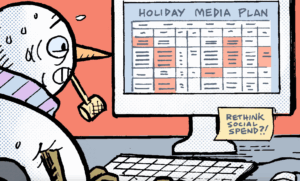 MAGNA Global, the strategic investment arm of Interpublic Group, revealed Wednesday it would shift $250 million from its TV budget into Google Preferred over a three-year period, making it the latest agency to commit big upfront dollars to YouTube.
MAGNA Global, the strategic investment arm of Interpublic Group, revealed Wednesday it would shift $250 million from its TV budget into Google Preferred over a three-year period, making it the latest agency to commit big upfront dollars to YouTube.
Other agencies, such as WPP, Publicis and Omnicom, have collectively committed “billions” through the Preferred program to date as YouTube steadily pursued brand budgets, according to a source with knowledge of Google, though MAGNA says this is the largest Google Preferred commitment to date.
Google Preferred is what Google terms the top 5% of videos on YouTube both in quality and performance.
MAGNA also, in 2014, made a $100 million commitment to Google Preferred.
The agency group is making this shift because linear TV ratings are declining, especially among 18-24-year-olds, and because supply is fragmenting.
Traditionally, said David Cohen, US president of MAGNA Global, the agency would source digital video budgets from digital, print or other areas.
“In the past, we weren’t taking a bite out of linear budgets for a number of reasons,” he said. “But really, over the last six months, we’ve been trying to knock down those barriers in earnest.”
MAGNA Global had historically refrained from porting linear TV dollars to digital video partly because of measurement and currency gaps. TV was historically bought and sold around ratings and programs; digital was sold on a cost-per-mille basis.
Consequently, television planners had difficulty forecasting pricing for digital video – programming that was like TV, but wasn’t actually TV.
But the more YouTube added ROI-based measurements, such as the ability to weigh the impact of digital ad exposures on offline sales and brand lift, the more it could court big agency and brand buyers. Cohen also noted YouTube’s willingness to make its premium inventory pricing “much more in line with some of our other television options.”
“In year one of the partnership, we’re clearly identifying what kind of inventory we want access to and what kinds of formats we want to run,” Cohen said. “We realize this is a marathon, not a sprint, so as time goes on we recognize that there will need to be new opportunities we include.”
So what does an agency get out of a Google Preferred deal? First of all, status. Part of the perk for MAGNA is it gets a “first look” at many new products coming down the pike.
“We’re fully confident we’ll be helping pioneer many of the new things YouTube is bringing to the table,” Cohen added.
MAGNA clients also get access to select Google Preferred programs. Cohen described two in which MAGNA can run 15- or 30-second ads – both skippable and nonskippable – against Google Preferred “Lineups,” which are more evergreen, or Google Preferred “Breakouts,” which are more “zeitgeist” and in-the-moment, said Cohen.
Although Cohen declined to comment on results for individual clients or campaigns, he said MAGNA has seen enough data points around brand lift, sales lift or a proxy metric to make a deeper investment worthwhile.
Cohen said he’s encouraged by several large platform companies that have laid the groundwork to deliver the flexibility and fluidity of digital in linear TV planning, and Google is certainly one of them.
“There are lots of ways to access YouTube inventory that’s not part of Google Preferred, but this partnership specifically looks at the crème de la crème of inventory that we can be confident with as a television replacement,” he said. “It is our hope in the next three years that there are material changes in the market where we can be much more nimble.”
Google declined to comment.












